AEG 6000BP User Manual
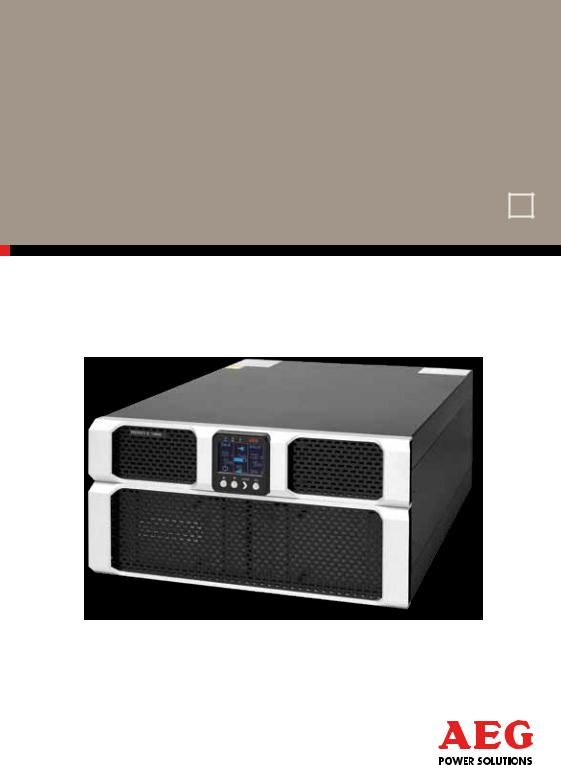
Operating Instructions
Protect D.
Protect D. 6000 (BP)
Protect D. 10000 (BP)
EN
2
3
Thank you for purchasing the Protect D. UPS from AEG Power Solutions.
The following safety precautions are an important part of these operating instructions. They are designed to help you avoid problems caused by operating errors and to protect you against any possible hazards. Please read these instructions carefully before using the product for the first time!
4
Contents
1. Notes on these operating instructions.............................................. |
6 |
2. General Information........................................................................... |
8 |
2.1 Technology......................................................................................................... |
8 |
2.2 System description............................................................................................ |
9 |
2.3 Technical data .................................................................................................. |
11 |
3. Safety Regulations............................................................................ |
16 |
3.1 General safety instructions.............................................................................. |
16 |
3.2 Safety instructions for the Protect D............................................................... |
16 |
3.3 CE certificate.................................................................................................... |
20 |
4. Installation........................................................................................ |
21 |
4.1 Unpack and check............................................................................................ |
21 |
4.2 Installation........................................................................................................ |
23 |
4.3 Assembly.......................................................................................................... |
23 |
5. Overview of connections, operating / display elements................ |
26 |
5.1 Front view......................................................................................................... |
26 |
5.2 Rear-panel view (connections):........................................................................ |
28 |
6. Electrical connection........................................................................ |
31 |
6.1 Safety of personnel ......................................................................................... |
32 |
6.2 Connection cross-section and fuses............................................................... |
32 |
6.3 Mains and consumer connection.................................................................... |
34 |
6.4 Contacting the battery modules..................................................................... |
36 |
6.4.1 Connecting the internal battery............................................................. |
36 |
6.4.2 Connecting external battery extension(s).............................................. |
39 |
7. Operation Mode and Operating..................................................... |
42 |
7.1 First start-up..................................................................................................... |
42 |
7.1.1 Switching on the UPS.............................................................................. |
42 |
7.1.2 Switching off the UPS ............................................................................ |
42 |
7.2 Usage table...................................................................................................... |
43 |
7.2.1 Overview.................................................................................................. |
43 |
7.2.2 Indicators (LEDs)...................................................................................... |
43 |
7.2.3 Operating keys (Navigation).................................................................. |
44 |
7.3 Display (Main Menu)........................................................................................ |
45 |
7.3.1 UPS status-display................................................................................... |
45 |
5
7.3.2 Event log.................................................................................................. |
49 |
7.3.3 Measurements......................................................................................... |
50 |
7.3.4 Control..................................................................................................... |
50 |
7.3.5 Identification............................................................................................ |
51 |
7.3.6 Settings.................................................................................................... |
51 |
8. Interfaces and communication......................................................... |
56 |
8.1 RS232 and USB computer interfaces............................................................. |
56 |
8.2 Communications slot....................................................................................... |
56 |
8.3 Shutdown and UPS management software................................................... |
57 |
8.4 EPO (Emergency Power Off)......................................................................... |
58 |
8.5 Change-over contact....................................................................................... |
59 |
9. Troubleshooting............................................................................... |
60 |
9.1 Malfunctions..................................................................................................... |
60 |
9.1.1 Alarm / error messages .......................................................................... |
61 |
10. Parallel operation........................................................................... |
65 |
10.1 Function.......................................................................................................... |
65 |
10.2 Installation / connection of parallel field operation .................................... |
66 |
11. Maintenance................................................................................... |
67 |
11.1 Charging the battery..................................................................................... |
67 |
11.2 Maintenance checks...................................................................................... |
67 |
11.2.1 Visual check........................................................................................... |
67 |
11.2.2 Battery check......................................................................................... |
68 |
11.2.3 Ventilator check..................................................................................... |
68 |
11.3 Battery replacement...................................................................................... |
68 |
12. Storage, Dismantling and Disposal............................................... |
70 |
12.1 Storage........................................................................................................... |
70 |
12.2 Dismantling.................................................................................................... |
70 |
12.3 Disposal.......................................................................................................... |
70 |
13. Appendix........................................................................................ |
72 |
13.1 Technical terminology.................................................................................... |
72 |
13.2 Keyword register ........................................................................................... |
74 |
13.3 Notes.............................................................................................................. |
75 |
6
1. Notes on these operating instructions
Obligation to provide instructions
These operating instructions are designed to help you properly and safely install and operate the following Uninterruptible Power Supply (UPS) systems: Protect D. 6000 and Protect D. 10000, as well as the corresponding external battery units, Protect D. 6000 BP and Protect D. 10000 BP, hereinafter collectively referred to as Protect D. This operating instructions contain important information on avoiding hazards.
Please read these instructions carefully before first use!
These operating instructions are part of the Protect D.
The operator of this device is required to make these operating instructions openly available to any person transporting, installing, servicing or performing any other work on the Protect D.
Validity
These operating instructions comply with the current technical specifications of the Protect D. at the time of publication. The contents do not constitute a contract and are for informational purposes only.
Warranty and liability
We reserve the right to make any changes to the information in this operating manual, with respect to the specifications and the operating instructions in particular, at any time.
Complaints about delivered goods must be submitted within eight days of receipt, along with the packing slip. Later claims will not be accepted.
Any damage incurred due to non-compliance with these instructions (including damage to the warranty seal) will void the warranty. AEG accepts no liability for consequential damages. AEG will rescind all obligations, such as warranty
agreements, service contacts, etc. without prior notice in the event that any spare parts other than original AEG spare parts or those purchased by AEG are used for maintenance and repair.
7
Handling
The Protect D. is designed and constructed so that all of the steps that need to be taken for its installation and operation can be done without having to open the device. Any maintenance or repairs are to be performed by qualified technicians only.
Illustrations are included to make certain steps clearer and easier to understand.
If there is any potential danger to personnel or equipment while performing certain work, these activities are accompanied by pictograms, whose meanings are explained in the safety instructions in chapter 3.
Hotline
If you still have questions after reading this operating manual, please contact your retailer or our hotline:
Tel: |
+49 (0)180 5 234 787 |
Fax: |
+49 (0)180 5 234 789 |
Internet: www.aegps.com
Copyright
Any forwarding, reproduction and / or storage, using electronic or mechanical means in whole or in part, of these operating instructions requires the express prior written consent of AEG.
© Copyright AEG 2012. All rights reserved.

8
2.General Information
2.1Technology
Protect D. is an uninterruptible power supply (UPS) for rack mounted loads such as
PCs, workstations, servers, network components and similar devices, consisting of:
•Network filter with surge protection (device protection / Class D) and mains back-feed protection
•Rectifier with PFC-logic (power factor correction unit)
•Separate input possibilities for rectifier and bypass (DUAL or SINGLE input)
•Separate intelligent battery charger with switch mode power supply technology
•Sealed system battery with maintenance-free design for energy storage in rack technology with downstream DC / DC converter unit
•3-level IGBT inverter for continuous supply to the connected loads with sinusoidal AC voltage
•Automatic, electronic bypass(SBS) as an additional passive redundancy SBS = Static Bypass Switch
•Removable terminal unit with outlets to IE60320, fitted with an automatic locking mechanism
•Manual bypass for maintenance and service purposes (with automatic static bypass activation, when operated)
•Parallel operation for the purpose of preparation of active redundancy or to increase power
•Control unit based on digital signal processor technology
•Multi-lingual LCD display designed to display remaining time and logs in real time
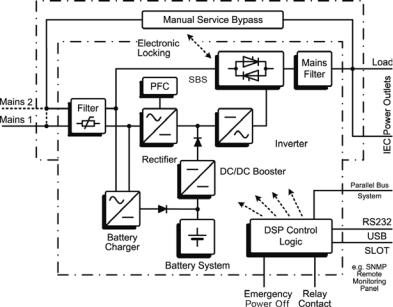
9
Fig. 1: Component diagram
2.2 System description
The UPS is connected between the public network and the power load segment to be protected.
The rectifier is powered from the mains and converts the AC voltage into a stabilized DC voltage to feed the inverter. The circuitry technology used (PFC), enables sinusoidal current consumption, thus allowing a low circuit feedback operation. A separate, second rectifier (charger) based on switching power supply technology, recharges or maintains the charge of the battery in the intermediate circuit. Due to the special circuitry technology used in this charger / rectifier, the harmonics of the charging current are reduced significantly. Additionally, a sleep mode considerably increases the service life of the battery. The inverter converts the DC voltage into a sinusoidal AC voltage. In combination with digital signal processor technology and extremely high pulse rate IGBT-power semiconductors in the inverter, a microprocessor-controlled regulator on the basis of pulse-width modulation (PWM) guarantees a voltage system of the highest quality and availability on the secured busbar.
10
In the event of mains problems (e.g. power outages), power is supplied to the load segment without an interruption from the inverter, which now uses the battery. Since no switching is required, the load segment experiences no power supply interruption at all.
The automatic bypass provides increased power supply security for single installations in particular by switching the public network, e.g. in the event of an inverter malfunction, through to the load segment directly and without interruption. In other words, the automatic bypass provides the load segment with an additional passive redundancy.
An integrated, manual bypass unit for maintenance and / or servicing provides an uninterrupted supply of power to the consumers. The connection unit is designed so that it can be separated from the UPS circuitry with minimal effort and can thus remain in the rack. Through this simplified line-side activation, servicing of the unit is possible at all times.
In order to ensure maximum security to the supply of the connected loads, the equipment was also prepared for parallel operation: a second UPS system provides maximum availability when used as an active redundancy. If, however, the demand for power is in the foreground, then the second UPS can be used for performance enhancing parallel operation.
The graphical LCD display used provides for versatile use and easy operation. Convenient features such as switchable outputs, a freely programmable, potential-free change-over contact, as well as an emergency power-off contact, round out the standard interface selection (USB, RS232 and communication slot).

11
2.3 Technical data
Type rating
Protect D. 6000 |
6000 VA (cos ϕ = 0.9 lag) 5400 W |
|
Protect D. 10000 |
10000 VA (cos ϕ = 0.9 lag) 9000 W |
|
UPS input |
1ph~ / N / PE (DUAL INPUT) |
|
Nominal input voltage |
200 / 208 / 220 / 230 / 240 Vac |
|
Rectifier voltage range |
176 Vac – 276 Vac |
|
(without battery operation, |
|
|
100 % load, cos ϕ = 0.9 lag) |
|
|
|
|
|
Rectifier voltage range |
120 Vac – 276 Vac |
|
(without battery operation |
|
|
50 % power reduction) |
|
|
|
|
|
Bypass voltage range |
184 Vac – 264 Vac |
|
|
|
|
Frequency |
50 Hz / 60 Hz (automatic detection or manually) |
|
|
|
|
Frequency tolerance range |
± 10 % |
|
Charging rate at full load |
Protect D. 6000 |
29 A (UN = 230 Vac) |
and battery charging (max.) |
Protect D. 10000 |
47 A (UN = 230 Vac) |
Circuit feedback factor |
λ ≥ 0.99 (THDi <5 %) |
|
UPS output |
|
|
Nominal output voltage |
200 / 208 / 220 / 230 / 240 Vac ± 1 % |
|
|
Power reduction at 200 Vac |
|
|
Nominal output voltage: 10 % |
|
|
|
|
Nominal frequency |
50 Hz / 60 Hz ± 0,5 % (Tolerance in battery mode |
|
|
or free running in frequency changer mode) |
|
|
|
|
Synchronization range |
50 Hz or 60 Hz ± 10 % |
|
Synchronization speed |
1 Hz / s |
|
Power factor range |
0.5 lag to 0.9 cap. at full power output |
|
|
Power reduction: 20 % to 0.5 cap. |
|
Frequency converter |
20 % power reduction |
|
|
(Bypass deactivated, frequency range 40 – 70 Hz) |
|
|
|
|
Waveform |
Sinus, distortion |
< 2 % THD (linear load) |
|
|
< 5 % THD (non-linear load) |
|
|
|
Crest factor |
3:1 |
|
|
|
|

12
Overload behavior |
To 102 % continuously; |
|
|
|
with existing network |
≥ 102 % – <130 % for 2 min. |
|
||
|
≥ 130 % – <150 % for 30 s |
|
||
|
Automatic seamless transfer to bypass mode (SBS) |
|||
|
|
|
|
|
Overload behavior |
to 130 % continuously; |
|
|
|
Bypass |
≥ 130 % – <180 % for 1 min. |
|
||
|
|
|
|
|
Overload behavior |
to 102 % continuously; |
|
|
|
when on battery |
≥ 102 % – <130 % for 10 s |
|
||
|
≥ 130 % for 100 ms |
|
|
|
|
|
|
|
|
Short circuit protection |
3 x IN for 100 ms |
|
|
|
Battery |
|
|
|
|
Autonomy time |
|
|
|
|
Coupled |
(cos ϕ = 0.9 lag / 100 % charged battery / 25°C) |
|||
battery module |
D. 6000 |
D. 6000 |
D. 10000 |
D. 10000 |
|
(rated load) |
(half load) |
(rated load) |
(half load) |
with integrated battery |
3 min. |
9.5 min. |
4 min. |
7.5 min. |
|
|
|
|
|
1 add. battery module |
11 min. |
27 min. |
9 min. |
18 min. |
|
|
|
|
|
2 add. battery modules |
20 min. |
46 min. |
15 min. |
30 min. |
|
|
|
|
|
3 add. battery modules |
30 min. |
68 min. |
21 min. |
43 min. |
|
|
|
|
|
4 add. battery modules |
40 min. |
91 min. |
27 min. |
57 min. |
Battery check |
Daily, weekly, monthly |
|
|
|
(programmable): |
|
|
|
|
Rated DC voltage |
Protect D. 6000 180 Vdc |
|
|
|
(DC Link) |
Protect D. 10000 240 Vdc |
|
|
|
Float voltage |
2.28 Vdc / cell (default 20°C) |
|
||
|
Charging voltage depending on temp. |
|
||
|
|
|||
Adjustment |
2.21 Vdc / cell – 2.31 Vdc / cell in 0.01 V increments |
|||
|
|
|
|
|
Temperature compensation |
20m V / 12 V-Block / °C |
|
|
|
|
|
|
|
|
Battery charging current |
1.4 Adc (Protect D. 6000) |
|
|
|
(max.) |
1.7 Adc (Protect D. 10000) |
|
||
|
|
|||
Switch-off |
1.60 to 1.75 V / cell (load and temperature |
|||
|
dependent) |
|
|
|

13
Battery voltage |
Visual and audible alarm at 1.90 V / cell |
|
|
|
|
Type of battery |
Sealed lead-acid battery (VRLA) |
|
|
spec. type for high-current discharge |
|
|
|
|
|
Protect D. 6000 |
15 blocks at 12 V 5 Ah |
|
|
|
|
Protect D. 6000 BP |
15 blocks at 12 V 9 Ah |
|
|
|
|
Protect D. 10000 |
20 blocks at 12 V 9 Ah |
|
Protect D. 10000 BP |
20 blocks at 12 V 9 Ah |
Recharging times |
~ 3h to 90 % for internal battery |
|
|
~9h / ~15h / ~21h / ~27h with 1 / 2 / 3 / 4 battery |
|
|
extension(s) |
|
Communication |
|
|
Interfaces |
RS232 (SUB-D (9-pin)), USB |
|
(DUAL Monitoring) |
Additional: communication slot for extensions |
|
|
(e.g. relay card / SNMP (PRO), etc.) |
|
|
|
|
EPO contact |
Potential-free |
|
|
(optionally programmable as opener or closer) |
|
|
|
|
Relay load-carrying ability |
250 Vac 3 A or 30 Vdc 3 A change-over contact |
|
|
(programmable) |
|
|
|
|
Shutdown software on CD |
“CompuWatch” for all popular operating systems, |
|
|
inc. Windows, Linux, Mac, Unix, Novell, Sun |
|
General information |
|
|
Classification |
VFI SS 111 acc. to IEC 62040–3 |
|
|
Double-conversion technology |
|
Full-load efficiency |
Protect D. 6000 |
> 92 % / >89 % |
(AC-AC / DC-AC) |
Protect D. 10000 |
> 93 % / > 90 % |
Full-load efficiency |
Protect D. 6000 |
> 96 % |
(ECO / transfer time < 10ms) |
Protect D. 10000 |
> 97 % |
|
|
|
Inherent noise (1m distance) |
<55 dB(A) |
|
|
|
|
Cooling |
External variable-speed cooling fan |
|
|
|
|
Operating temperature range 0°C bis +40°C |
|
|
|
Recommended: +15°C to +25°C |
|
|
(battery system dependent) |
|
|
|
|
Storage temperature range |
-15°C to + 60°C (UPS) |
|
|
0°C to + 35°C (battery) |
|
|
|
|

14
Humidity |
0 - 95 % (non-condensing) |
|
|
|
|
Installation height |
Up to 1000 m at nominal power (for use above |
|
|
1000 m, power loss is equal to 1 % per 100 m) |
|
|
|
|
Protection |
IP20 |
|
Connections |
|
|
Mains connections |
Fixed connection (separate connections for |
|
(DUAL or SINGLE) |
GR and bypass (bridged)) |
|
Consumer connections |
Protect D. 6000 |
2 x IEC320 C13 |
with automatic locking |
|
1 x IEC320 C19 |
(in addition to standard |
Protect D. 10000 |
4 x IEC320 C19 |
landline) |
|
|
|
|
|
Display |
Graphic LCD display, Resolution: 128 x 64 pixels |
|
|
Languages: EN / DE / ES / FR / RU |
|
|
incl. 3 LEDs for operating display |
|
|
|
|
Housing color |
Black line with aluminum front |
|
|
|
|
Weight (net / gross) |
Protect D. 6000 |
46 kg (20 kg without |
|
|
battery) / 53 kg |
|
Protect D. 10000 |
82.5 kg (32.5 kg without |
|
|
battery) / 91 kg |
|
Protect D. 6000 BP |
44.5 kg / 53.0 kg |
|
Protect D. 10000 BP |
63.0 kg / 71.5 kg |
|
|
|
Dimensions (net) |
Protect D. 6000 |
W 438 mm x D 715 mm x |
|
|
H 132 mm |
|
|
|
|
Protect D. 10000 |
W 438 mm x D 715 mm x |
|
|
H 220 mm, Depth with |
|
|
front cover plus 35mm |
|
|
|
|
In combination with the mounting brackets, |
|
|
a standard rack measures 19" = 482.6 mm. |
|
|
Height: 3U (6 kVA) / 5U (10 kVA) |
|
|
|
|
|
D. 6000 BP & |
W 438 mm x D 595 mm x |
|
D. 10000 BP |
H 132 mm, (depth |
|
|
including the front panel) |
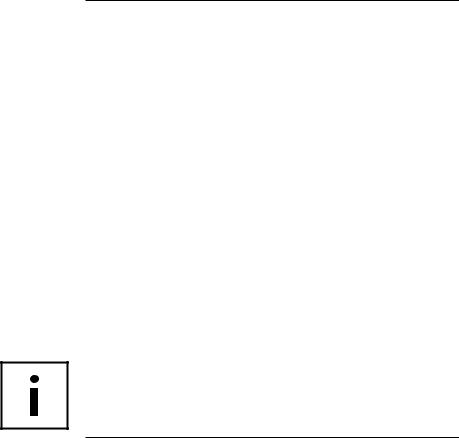
15
Dimensions |
Protect D. 6000 |
W 580 mm x D 800 mm x |
(gross (packaged)) |
|
H 540 mm |
|
|
|
|
Protect D. 10000 |
W 580 mm x D 800 mm x |
|
|
H 675 mm |
|
|
|
|
Protect D. 6000 BP |
W 580 mm x D 800 mm x |
|
|
H 355 mm |
|
|
|
|
Protect D. 10000 BP |
W 580 mm x D 800 mm x |
|
|
H 355 mm |
|
|
|
Guidelines |
The Protect D. complies with the EN 62040 |
|
|
product standard. |
|
|
The CE seal on the device confirms compliance |
|
with the EG Low Voltage Directive 2006 / 95 / EG and EMC Directive 2004 / 108 / EG for electromagnetic compatibility, if the installation instructions provided in this manual are followed.
For 2006 / 95 / EG Low Voltage Directive
Reference number EN 62040-1: 2008
For 2004 / 108 / EG EMC Directive
Reference number EN 62040-2: 2006 class C2
Warning:
This is a category C2–UPS product. In a domestic environment, this product may cause radio interference, in which case the user may be required to take additional measures.

16
3.Safety Regulations
3.1General safety instructions
Read these operating instructions carefully before using the UPS Protect D. and its external battery modules (special accessories) for the first time; pay careful attention to the safety precautions!
Use this device for its intended purpose only and in accordance with the safety instructions and danger warnings in this instruction manual! The device is to be used only when it is in perfect working condition; correct any problems that may affect the safety of the device immediately.
The following pictograms appear in this manual:
Note: Danger!
In the case of danger to life and limb of the operator.
Note: Attention!
Risk of injury and / or risk of damage to equipment and equipment parts.
Note: Information!
Useful and important for the operation of the UPS and the external battery modules (optional).
3.2 Safety instructions for the Protect D.
This chapter contains important safety instructions for the UPS Protect D. and its external battery modules (optional accessories) that must be followed for the mounting, operation and maintenance of the uninterruptible power supply and the battery system (internal and external batteries, if applicable).

17
The UPS is an electrical device that can be dangerous. The device should only be opened by qualified personnel. Repairs should only be carried out by qualified service personnel!
The output can also be electrically charged, even if the UPS is not connected to the mains power supply. The UPS has its own internal power supply (battery)!
To ensure operator safety, the device must be properly grounded!
The Protect D. must only be connected and operated with a VDE-approved power cord with a grounding conductor to 200 V / 208 V / 220 V / 230 V / 240 V AC voltage networks with a protective ground.
Caution – Risk of burns!
The battery has a high short-circuit current. Connection or disconnection errors can lead to the melting of plug connections, to arcing and to severe burns!
The device is equipped with a warning signal that sounds when the Protect D. battery is discharged or when the UPS is not working in the normal mode (see also chapter 9.1.1 “Alarm- / error messages”, from page 61).
To ensure the safe operation and reliability of the UPS and battery modules (optional), observe the following safety instructions:
•Do not attempt to open the UPS! (The UPS does not contain any parts that require regular maintenance. Please note that if the UPS has been opened, any warranty claims with be voided)
•Do not expose the device to direct sunlight or a direct heat source!
•The unit is designed for installation in temperature controlled indoor rooms. Do not install the device close to water or in very humid areas!
•If the UPS is brought from a cold environment into the installation area, condensation may occur. Before using the UPS, it must be absolutely dry; therefore a waiting time of a minimum of two hours before use is required.
•Never connect the mains power input with the UPS output!

18
•Ensure that no liquids or foreign objects enter the housing!
•Do not block the ventilation openings of the device! Make sure, for example, that children do not insert anything into the ventilation openings!
•Never connect any household appliances, e.g. a hair dryer, to the UPS!
Also be careful when operating the device with power loads. Any feedback to the inverter, e.g. due to a short-term generator operation of the load, must be avoided at all costs.
•The power outlet should be located near the unit and with easy access in order to make it easier to deactivate the AC input or pull out the plug!!
•While the device is in operation, do not pull the plug from the UPS or from the network power supply outlet (grounded power outlet). This will cancel the ground for the UPS and all of the load segments connected.
Danger of electric shock!
Even when the mains power supply has been disconnected, parts inside the UPS are still connected to the battery and can give you an electric shock. Before
attempting any maintenance or service work, always disconnect the battery circuit!
Battery replacement and servicing must be done or at least supervised by a qualified technician, who is familiar with the batteries and the safety precautions that have to be taken!
Do not allow unauthorized access to the batteries!
When replacing the batteries, please note: Use only identical, maintenance-free, valve regulated lead acid batteries with exactly the same specification as the original batteries. Ask your AEG dealer for the appropriate battery tray.
Danger of explosion!
Do not dispose of batteries in an open fire.
Do not attempt to open or interfere with the batteries (the electrolytes released will harm skin and eyes and can also be toxic!)
Batteries can cause electrical shock and high short circuit current.

19
Whenever you work with batteries, please take the following precautions:
•Remove all watches, rings and any other metallic jewelry!
•Use only tools with insulated handles!
Do not use connecting blocks with central on / off switches to prevent switch-on current peaks.
Switch the UPS to “OFF” if you don’t want to use it for a longer period of time. If your company switches off the power, then the Protect D. has to be switched off as well. Otherwise, the battery will run down. To prolong battery life, avoid running the battery down frequently!
For your own protection, never switch on the UPS when the plug has been pulled from the Protect D.!
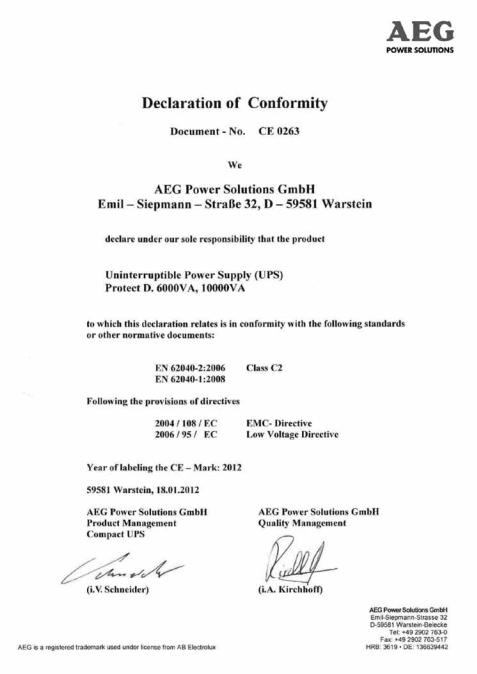
20
3.3 CE certificate
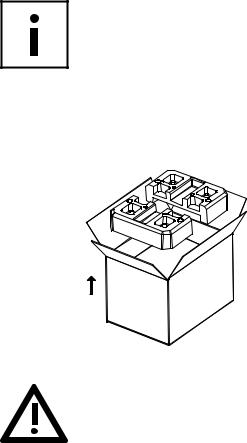
21
4.Installation
4.1Unpack and check
The device has been extensively tested and checked. Although packaging and shipping has been carefully carried out, damage in transit cannot be totally ruled out.
Any transport damage claims must be made directly to the shipping company!
Upon receipt, check the contents of the transport containers for any damage. If necessary, ask the shipping company to check the goods and make a note of any damages while an employee of the shipping company is still present and report the damage within eight days of receipt to an AEG representative or retailer.
Check the contents for completeness:
After opening, the top level of the carton contains:
• Rack rail kit
• Mounting brackets
• 3 cable glands
• Power cord
• 2 communication cables (RS232 and USB)
• “CompuWatch” management software on CD
• Safety precautions & Operating instructions
• Product registration card
Fig. 2: Extract – stage 1
Handle components with care paying particular attention to the weight.
Two people may be required to move the battery units.
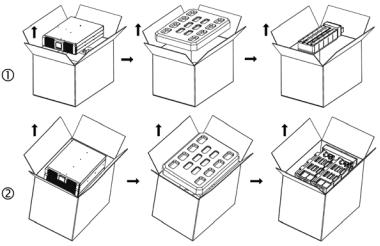
22
•Middle level
1 Protect D. 6000 () or Protect D. 10000 ()
Fig. 3: Removal of the UPS and it’s accessories
Lower level
•1 connection unit (the bar containing the terminals, the manual bypass and IEC outlet distribution)
•1 battery tray for D. 6000, respectively
2 battery trays for D. 10000
External battery modules include the following:
•External battery unit Protect D. 6000 BP or D. 10000 BP
•1 small oblong box containing the rack rails kit including fixing screws and cage nuts
•2 mounting brackets incl. bolts for final fixation to the front spar of the cabinet frame
Please report any deviations to our hotline (see page 7).
The original packaging provides effective protection against damage and should be kept in case the device has to be transported at a later date.
Always keep plastic bags away from babies and children in order to prevent suffocation.

23
4.2 Installation
The Protect D. is designed to be installed in a protected environment. When choosing the location, make sure that there is adequate ventilation and any other environmental requirements deemed appropriate.
The Protect D. is air-cooled. Do not block vents or openings!
The UPS and its battery modules in particular, should preferably be operated at room temperature (between 15°C and 25°C).
Install the devices in a room that is dry, relatively dust-free and free of chemical vapors.
Make sure that no magnetic storage media are stored and / or operated in the vicinity of the Protect D.
Check the type rating plate to make sure that the voltage and frequency specifications match those of your load segments.
4.3 Assembly
For rack installation of the UPS system and its external battery units (Optional accessories), please note the following:
•To prevent damage from vibration and shocks, the installation location has to have adequate stability.
•Make sure that racks are able to support the installation.
•Place any external battery units directly underneath the UPS system.
To ensure maximum mechanical stability, place each tray in its own rack mount.
•Due to their heavy weight, install the units in the lower part of the cabinet.
•Install the units allowing for adequate air circulation.
•External battery packs are to be placed directly below the UPS system. To maintain maximum mechanical stability, mount each tray on a pair of separate rack rails.
•Avoid extremes of temperature! In order to maximize battery life, an environmental temperature of 15°C to 25°C is recommended. Do not expose the units to direct sunlight or operate them close to any other heat sources, e.g. radiators.
